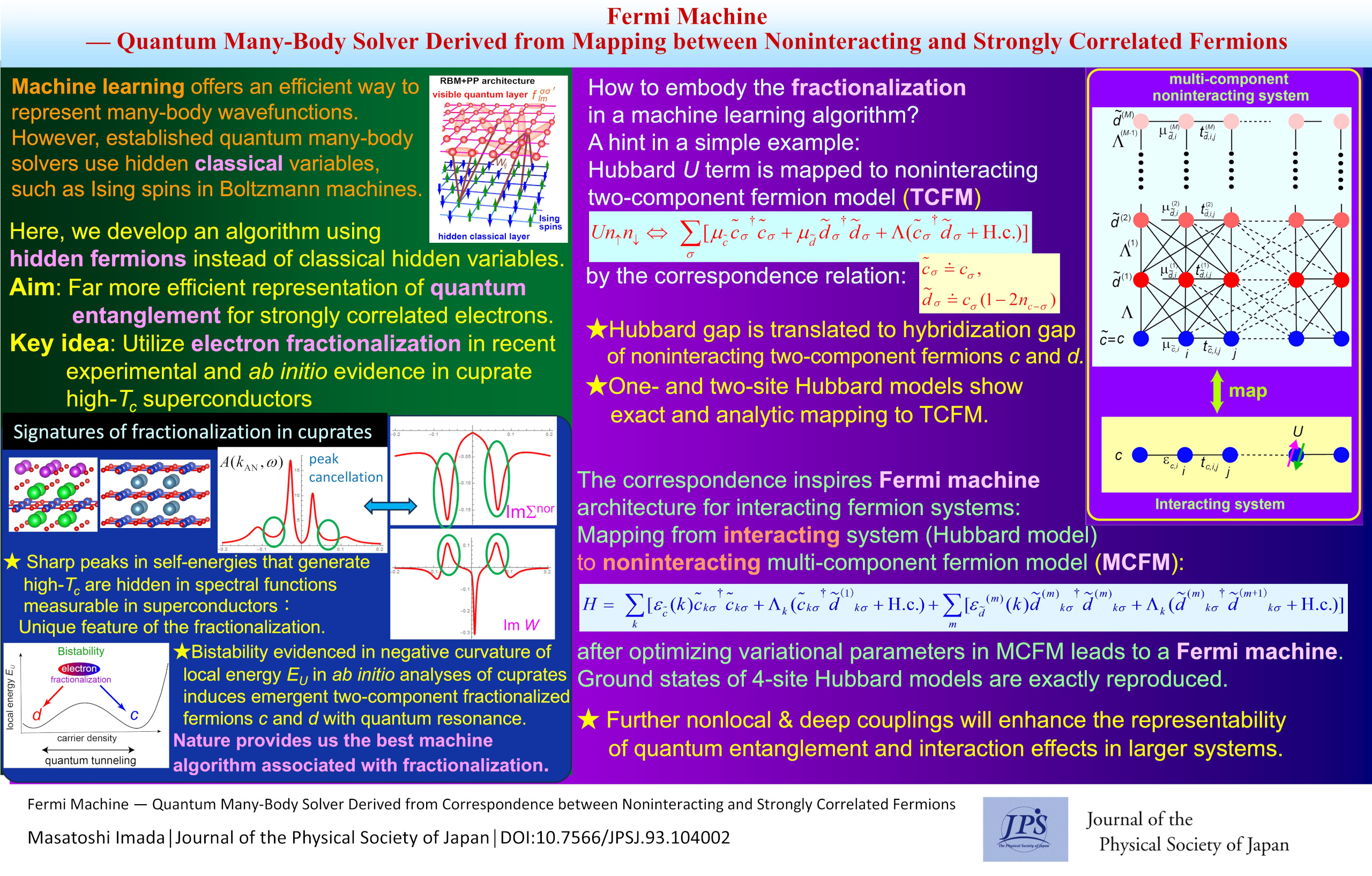Fermi Machine — Quantum Many-Body Solver Derived from Mapping between Noninteracting and Strongly Correlated Fermions
© The Physical Society of Japan
This article is on
Fermi Machine — Quantum Many-Body Solver Derived from Correspondence between Noninteracting and Strongly Correlated Fermions
J. Phys. Soc. Jpn.
93,
104002
(2024)
.
Strongly interacting quantum many-body states can be mapped to noninteracting quantum states, enabling a new quantum neural network called the Fermi machine to solve strongly correlated electron problems.

When attempting to reach the exact ground states of interacting quantum systems, the computational cost increases exponentially with the system size in most cases and is thus intractable, which is known as an NP-hard problem. Unless accurate quantum computers become available, approximate but sufficiently accurate algorithms that are applicable to conventional computers need to be developed. This demand is particularly strong in research fields, such as condensed matter, high-energy physics, and chemistry.
Various methods have been developed to achieve these objectives. Recently, artificial neural networks based on machine learning have demonstrated promising performances. For instance, they contribute to establish the existence of a quantum spin liquid that embodies strong long-range quantum entanglement, which is expected to be useful in quantum computers and information transmission.
However, the existing neural networks employ classical variables, such as Ising spins for hidden variables in Boltzmann machines, to represent the interaction and entanglement effects. As quantum entanglement is not efficiently handled by classical operations, hidden quantum variables that efficiently handle long-range quantum entanglement are desired to be incorporated.
The question then is how to build an architecture that incorporates hidden quantum variables. A hint was provided by a recent understanding of strongly correlated electrons, particularly achieved by machine-learning analyses of spectroscopic experimental data and ab initio calculations of cuprate high-Tc superconductors. The key understanding is that electrons in the cuprates behave as if the original single electron is splintered into two noninteracting fermions, dubbed “electron fractionalization”, a remarkable but ubiquitous feature if bistability exists, as in examples near the first-order transitions.
A striking idea from this fractionalization is that strongly correlated fermions may be mapped to noninteracting systems, where the fractionalization is embodied by mutually hybridizing multiple components of fermions. As treating strong interaction and many-body entanglement is a widely recognized grand challenge, it would be astonishing if it is mapped to tractable noninteracting systems. One might be suspicious about this “free lunch”.
In this study, by taking the Hubbard model, known as a simple but challenging model of strongly correlated electrons, the exact mapping of the full Hilbert space of one- and two-site Hubbard models, to a two-component noninteracting fermion model (TCFM) is established. An extension of the mapping to larger systems and the architecture of the noninteracting multicomponent fermion model (MCFM) are proposed to simulate an any-sized Hubbard model, which enables a new quantum many-body solver called the Fermi machine. The Fermi machine easily treats quantum entanglement through the hybridization of hidden fermions and physical electrons, and easily reproduces the Mott insulator as well as the pseudogap states in cuprate superconductors by hybridization gaps.
The algorithm was tested for the four-site Hubbard model, and it easily reproduced the exact ground state by the MCFM. The Fermi machine has significant potential for accurate and functional quantum many-body solvers by utilizing the nature and structure of strongly correlated real electrons. The concept of mapping between strongly interacting quantum particles and tractable noninteracting quantum systems will provide the basis for a deeper understanding of the interacting quantum world.
(Written by Masatoshi Imada)
Fermi Machine — Quantum Many-Body Solver Derived from Correspondence between Noninteracting and Strongly Correlated Fermions
J. Phys. Soc. Jpn.
93,
104002
(2024)
.
Share this topic
Fields
Related Articles
-
Exploring the Vibrant Interplay of Machine Learning and Physics
Cross-disciplinary physics and related areas of science and technology
Electron states in condensed matter
Elementary particles, fields, and strings
Mathematical methods, classical and quantum physics, relativity, gravitation, numerical simulation, computational modeling
Statistical physics and thermodynamics
Superconductivity
2025-3-13
This Journal of the Physical Society of Japan Special Topics edition explores how physics and machine learning complement each other and can solve unresolved problems in physics.
-
Excitonic Insulators: Challenges in Realizing a Theoretically Predicted State of Matter
Electron states in condensed matter
Electronic transport in condensed matter
2025-3-3
The realization of an excitonic insulator can help in the establishment of a new electronic state in condensed matter physics, one that has the potential to exhibit novel electric, magnetic, and optical responses beyond those of conventional materials.
-
Symmetry and AI: Building the Future of Physics Simulations
Magnetic properties in condensed matter
Measurement, instrumentation, and techniques
2025-2-18
Generative artificial intelligence (AI) has gained considerable attention in scientific fields. By embedding physical symmetry into AI before training, we created a faster and lighter model. Scaling improves the accuracy and unlocks the potential of physics research and applications.
-
Bayesian Insights into X-ray Laue Oscillations: Quantitative Surface Roughness and Noise Modeling
Measurement, instrumentation, and techniques
Structure and mechanical and thermal properties in condensed matter
2025-2-14
This study adopts Bayesian inference using the replica exchange Monte Carlo method to accurately estimate thin-film properties from X-ray Laue oscillation data, enabling quantitative analysis and appropriate noise modeling.
-
Exploring Materials without Data Exposure: A Bayesian Optimizer using Secure Computation
Cross-disciplinary physics and related areas of science and technology
Measurement, instrumentation, and techniques
2025-2-6
Secure computation allows the manipulation of material data without exposing them, thereby offering an alternative to traditional open/closed data management. We recently reported the development of an application that performs Bayesian optimization using secure computation.




